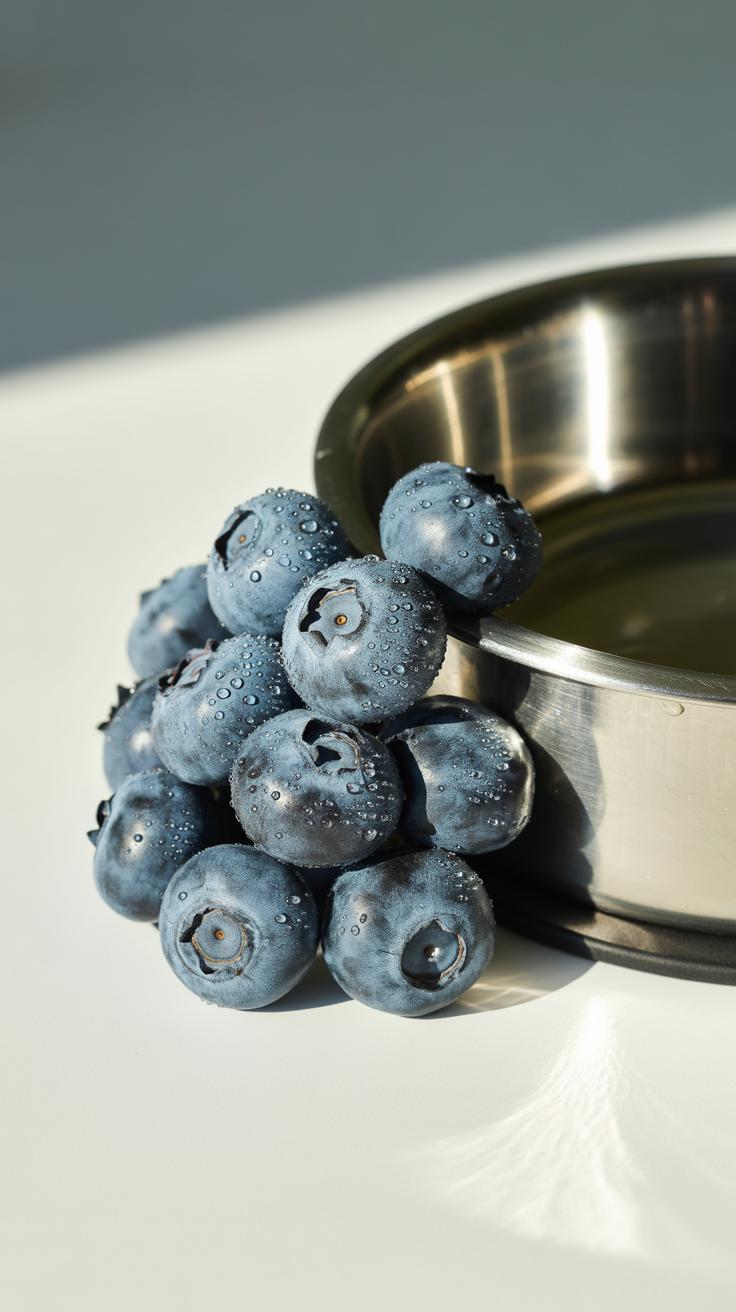Introduction
Blueberries are more than just a tasty snack for humans. They can also be a good addition to your dog’s diet, offering several health benefits. Knowing how to safely include blueberries can help keep your dog happy and healthy. This article explores the topic of Blueberries For Dogs Benefits Portions And Easy Treats, giving you useful information to start feeding your dog this fruit.
You will learn about the main advantages blueberries provide, understand the right portion sizes, and discover simple ways to turn blueberries into treats your dog will enjoy. This information helps ensure you give your dog a snack that supports their wellbeing without causing harm.
Why Blueberries Are Good For Dogs
You might wonder why blueberries keep popping up as a recommended treat for dogs. It’s not just because they’re tasty—though many dogs seem to enjoy the slightly sweet, tangy flavor—but because they offer several benefits that can contribute to your dog’s overall health.
Blueberries are packed with antioxidants, vitamins, and fiber, a combination that supports your dog’s wellbeing in different ways. The antioxidants help neutralize harmful molecules, which can damage cells over time. That’s significant because dogs, just like us, face oxidative stress that might contribute to aging or illnesses. The vitamins in blueberries, like vitamin C and K, play roles in keeping the immune system strong and supporting bone health. These nutrients can be subtle powerhouses behind your dog’s daily vitality.
And then there’s fiber, which some might overlook. Fiber doesn’t just keep your dog’s digestive system running smoothly—it also influences gut health and even appetite control. A bit of fiber can mean fewer tummy troubles and more regular bowel movements, something every dog owner appreciates. So, it’s not just a simple snack; blueberries can quietly contribute to your pet’s health in a few important ways.
Antioxidants And Vitamins In Blueberries
Blueberries contain different antioxidants, including flavonoids and anthocyanins—the compounds that give them their blue color. These antioxidants help to protect cells from damage caused by free radicals, which are unstable molecules that can harm cell structures. Why does this matter for dogs? Protecting cells means supporting the immune system and possibly delaying some effects of aging.
The vitamin content is also notable. Vitamin C, for example, assists in collagen formation, which is important for skin and joint health. Vitamin K, though less talked about, helps with blood clotting and bone strength. Dogs produce some vitamin C naturally, but extra from foods like blueberries could still offer benefits. Some dog owners have shared noticing shinier coats or better energy after adding blueberries—though these effects might vary pet to pet.
Fiber And Digestive Health
When you think about fiber in blueberries, it’s mostly soluble fiber, which dissolves in water and forms a gel-like substance in the stomach. This type of fiber can slow digestion slightly, helping regulate blood sugar spikes and keeping your dog feeling full longer. But importantly, fiber acts as a gentle cleaner for the gut, encouraging healthy bacteria and supporting smooth bowel movements.
If your dog tends to have irregular stools or mild digestive upset, small amounts of fiber from blueberries might be helpful. It’s a natural way to promote gut health without medicines or supplements, though it’s not a fix-all. Fiber doesn’t just aid digestion; it plays a part in overall metabolism, which could unknowingly affect your dog’s weight and energy levels.
How To Safely Introduce Blueberries To Your Dog
When adding blueberries to your dog’s diet, it’s best to start cautiously. Small portions are key. Maybe begin with one or two berries, especially if your dog hasn’t tried fruits before. This way, you can get a feel for how their body reacts without overwhelming their system.
Watch your dog closely after the first taste. Positive signs might be enjoyment, a bit of excitement, or simply no change at all. Watch out though—if you notice vomiting, diarrhea, excessive scratching, or swelling, those could mean a negative reaction or even an allergy. Some dogs can be sensitive, even if you wouldn’t expect it.
The tricky part is that reactions might not always show immediately. Sometimes, a slight stomach upset can come a few hours later, or certain itchiness might take time to reveal itself. It’s a good idea to give a day or so between new blueberry servings before increasing the amount.
Being patient helps. If your dog seems fine with the small amount, you can try adding a few more next time. But if anything seems off, pause and check with your vet. Quick response to any sign of trouble is just better for your furry friend’s wellbeing, even if it means putting blueberries on hold for a bit.
Recommended Blueberry Portions For Different Sized Dogs
Portion Sizes For Small Dogs
When it comes to small breed dogs, portion control is key. These little pups don’t need many blueberries—maybe around three to five berries per serving. It might seem like just a few, but their tiny bodies can’t handle too much fruit at once. Overfeeding could upset their stomach or add unnecessary sugar to their diet. I’ve seen small dogs nibble enthusiastically, but too many often lead to a bit of an upset tummy. So, it’s better to keep it light.
Feeding just a handful as an occasional treat keeps things safe and enjoyable. Think of it as a fun snack rather than a meal replacement. Small dogs can truly benefit from these berries, but always keep a close eye on how they react, especially the first few times.
Portion Sizes For Medium And Large Dogs
Medium and large dogs can handle more blueberries, but it’s not an unlimited snack. For medium breeds, about 5 to 10 berries per serving should be just fine. For larger dogs, you can offer up to 10 or 15 berries. The difference isn’t huge, but it reflects their ability to digest and use the nutrients more comfortably.
Still, you wouldn’t want to give a whole cup of blueberries—they’re tasty, sure, but too many might cause digestive troubles or add extra calories that could affect weight. I like to think of it as a small boost to their day rather than a bulk treat. And sometimes, even if your dog is big, they may only want a few bites. It depends.
When you’re ready to offer blueberries, watching your dog’s reaction helps you adjust portions wisely—there’s a bit of trial and error to get it just right.
Easy Blueberry Treat Ideas For Your Dog
Frozen blueberries make a surprisingly simple treat, especially during warmer days. Just rinse the berries, spread them out on a baking sheet, and pop them in the freezer. After a few hours, you’ll have handy, bite-sized snacks that stay cool and refreshing—perfect for dogs who enjoy crunch or need a little help cooling off. Of course, some dogs might prefer them thawed or mixed in, so feel free to experiment.
Mixing fresh blueberries into your dog’s regular food can be a low-effort way to add both flavor and nutrients. Toss a handful of berries into their kibble or wet food just before serving. The natural sweetness often encourages picky eaters to finish their meals. You could even mash the berries slightly to release their juice, but many dogs enjoy the burst of texture from whole blueberries.
If you want to get creative, try blending blueberries with a bit of plain yogurt and freezing the mixture in small silicone molds. It’s easy. And dogs usually love the combination. Though, you might want to watch how much yogurt you add, since some dogs can be sensitive to dairy. Either way, it’s a nice way to sneak in those antioxidants without fuss.
Potential Risks Of Feeding Blueberries To Dogs
Choking And Digestive Issues
Feeding blueberries to your dog isn’t without some risks, especially if you don’t pay close attention to size and quantity. Blueberries are small, but for tiny dogs, a whole berry could pose a choking hazard. I’ve seen dogs try to gulp them down too fast, which isn’t great. Cutting blueberries in half or even crushing them can help avoid this.
Moderation matters, too. Offering too many blueberries in one go might upset your dog’s stomach. It can lead to diarrhea or gas, which no one wants. So, starting with just a few berries and watching your dog’s response is wise.
Allergic Reactions And Food Sensitivities
Though rare, some dogs might show mild allergies or sensitivities to blueberries. Signs to watch for include itching, swelling around the face, or unusual licking. Digestive symptoms like vomiting also deserve attention.
If your dog develops any of these after eating blueberries, stop feeding them immediately and check with your vet. Sometimes what seems like a harmless snack can trigger reactions you wouldn’t expect. Have you noticed any odd reactions when introducing new foods? It’s always a bit of a guessing game at first.
Nutritional Comparison Between Blueberries And Commercial Dog Treats
Natural Nutrients Vs Processed Ingredients
Blueberries come packed with vitamins like C and K, fiber, and antioxidants—nutrients your dog’s body actually recognizes and uses. Commercial dog treats often contain fillers, artificial flavors, and preservatives that don’t offer much beyond calories. These additives can sometimes irritate sensitive stomachs or trigger allergies, which might leave you wondering if natural really is better.
Sure, the convenience of store-bought treats is hard to beat, but with blueberries, you get a simple, clean ingredient that supports health rather than just tasting good. It’s a more straightforward option, without any mystery chemicals.
Calories And Weight Management
One blueberry has roughly one calorie. Compare that to many treats that can pack 50 calories or more for just a small piece. If your dog tends to get a bit pudgy—or maybe, like mine, gets overly excited for snacks—blueberries are a low-calorie way to satisfy them without packing on extra pounds.
You might find yourself more willing to give a few blueberries than a chunk of processed treat because it feels lighter, healthier, and less risky for weight gain. It’s simple math, really: fewer calories, less guilt. But yes, it does mean you’ll need to offer more berries to match treat volume, which can get a bit messy.
How Blueberries Support Your Dogs Long Term Health
Feeding your dog blueberries regularly—but in proper amounts—can have noticeable effects on their health over time. I’ve noticed that when my dog gets a few blueberries now and then, he seems less sluggish and more alert, especially in his older years. There’s something about those tiny fruits that really does more than just add flavor.
Blueberries pack antioxidants, like flavonoids and vitamin C, which help your dog’s immune system stay stronger. These compounds fight off cell damage caused by free radicals, which can wear down the body’s defenses as time passes. So, giving blueberries might mean fewer sick days and better recovery for your furry friend—though it’s not a magic shield, of course.
Besides immune support, vitamins in blueberries—like vitamin K and manganese—play roles in brain and eye health. That intrigues me because cognitive decline can creep in silently as dogs age. Maybe those nutrients help keep their focus sharper and eyesight clearer. I sometimes wonder if a bit of blueberry snack is one of the reasons my dog still chases squirrels enthusiastically at ten years old.
- Antioxidants in blueberries help reduce inflammation and boost immune response.
- Vitamin C replenishes cells and aids in maintaining a healthy coat and skin.
- Vitamins and minerals contribute to proper nerve function supporting mental sharpness.
- Nutrients linked to eye health can slow down degenerative changes in vision.
Could blueberries be more than just a treat? When offered thoughtfully, they might quietly support your dog’s well-being over the long haul. Still, it’s good to keep an eye on how your dog responds individually—no two pets are exactly alike.
Questions To Ask Your Veterinarian About Feeding Blueberries
Is My Dog Ready For Blueberries
Before offering your dog blueberries, it’s a good idea to check with your vet. Here are a few questions to consider:
–
Does my dog have any allergies or sensitivities that might make blueberries unsafe?
–
Are there existing health issues, like diabetes or digestive problems, that blueberries could affect?
–
What’s the best serving size for my dog’s breed and weight?
–
Could blueberries interfere with any medications or treatments my dog is currently on?
Sometimes vets suggest avoiding new foods for dogs with very sensitive stomachs or chronic illnesses. I remember once trying blueberries with a pup who had a delicate gut, and it didn’t go well. That’s why this step feels worth it, even if it’s a bit tedious.
Monitoring Health After Introducing Blueberries
Once your dog starts eating blueberries, watching for changes is key. You might want to keep an eye on:
–
Any shifts in bowel movements – diarrhea or constipation can hint at intolerance.
–
Skin or coat reactions, like itching or rashes, which could point to allergies.
–
Energy levels and mood – if your dog seems unusually tired or restless after eating blueberries.
It’s helpful to jot down notes or even take photos if something changes. When you talk to your vet, sharing these observations can make all the difference. I found that tracking a simple daily log saved me a lot of guesswork when I checked in.
Also, don’t hesitate to ask your vet when’s the right time to introduce other fruits. Some can boost benefits, others might cause issues. Feeding new foods in stages, not all at once, usually lets you see what suits your dog best.
Conclusions
Feeding blueberries to your dog can be a positive choice if you do it right. Blueberries offer antioxidants, vitamins, and fiber that support your dog’s health. Keeping portions moderate and observing your dog’s response is key to avoiding any issues.
Using blueberries as treats or food toppers adds variety to your dog’s diet in a natural way. By following simple guidelines on serving size and preparation, you can introduce blueberries safely. This gives your dog a tasty snack with nutritional benefits without replacing their balanced diet.





















